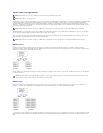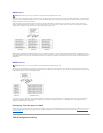
NIC
(On default)
setting is active, if a boot routine is not available from the network server, the computer attempts to boot from the next device in the boot
sequence list.
Integrated
Audio
(On default)
Enables or disables the onboard audio controller.
1394
Controller
(On default)
Enables or disables the 1394 controller.
USB
Controller
(On default)
Enables or disables the internal USB controller. No Boot enables the controller but disables the ability to boot from a USB device.
NOTE: Operating systems with USB support will recognize USB floppy drives regardless of the No Boot setting.
Front USB
Ports
(On default)
Enables or disables the front USB ports.
USB for
Flexbay
(On default)
On enables internal USB for FlexBay.
NOTE: This USB option appears only if a FlexBay device is installed.
LPT Port
Mode
(PS/2
default)
Determines the mode of operation of the internal parallel port. Off disables the port. AT configures the port for AT compatibility. PS/2
configures the port for PS/2 compatibility. EPP configures the port for the EPP bidirectional protocol. ECP configures the port for the ECP
bidirectional protocol.
NOTE: If you set the LPT Port Mode to ECP, the LPT Port DMA appears in the option menu.
LPT Port
Address
Determines the address that the built-in parallel port uses.
Serial Port
#1
(Auto
default)
Determines how the serial port operates.
Auto, the default setting, automatically configures a connector to a particular designation (COM1 or COM3).
Serial Port
#2
(Auto
default)
Determines how the serial port operates.
Auto, the default setting, automatically configures a connector to a particular designation (COM2 or COM4).
PS/2 Mouse
Port
(On default)
Enables or disables the integrated legacy PS/2-compatible mouse controller.
Video
Primary Video
(PEG default)
This setting specifies which video controller is primary, PCI or PEG. PEG is the appropriate setting for a PCI Express graphics card or cards.
Performance
HyperThreading
(On default)
Determines whether the physical processor appears as one or two logical processors. The performance of some applications improves
with additional logical processors installed. On enables hyperthreading.
NOTE: HyperThreading may not be supported on your computer.
Multiple CPU
Core
(On default)
Determines whether the processor will have one or two cores enabled. On enables the second core.
SpeedStep
(Off default)
Enables Intel®SpeedStep®for all supported processors in the computer. This setting changes the processor power consumption and
frequency.
NOTE: This option may not be available on your computer.
Virtualization
(Off default)
Specifies whether a virtual machine monitor (VMM) can utilize the additional hardware capabilities provided by Intel Virtualization
technology.
Limit CPUID
Value
Limits the max value the processor standard CPUID function will support. Some operating systems won't complete installation when the
max CPUID function supported is greater than 3.


















